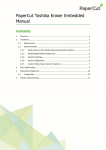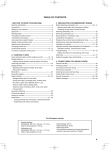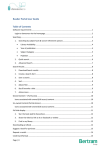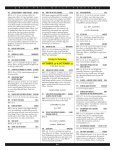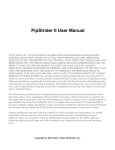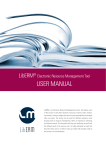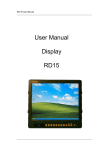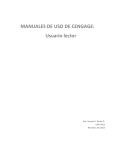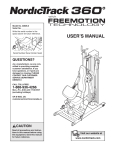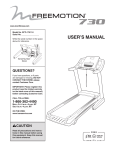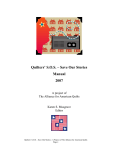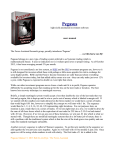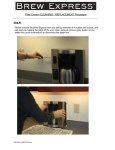Download Free-Motion Quilting
Transcript
Easy and Fun Free-Motion Quilting Frames, Fillers, Hundreds of Ideas Eva A. Larkin Easy and Fun Free-Motion Quilting: Frames, Fillers, Hundreds of Ideas © 2012 by Eva A. Larkin Martingale® 19021 120th Ave. NE, Ste. 102 Bothell, WA 98011-9511 USA ShopMartingale.com eBook Edition: 2013 No part of this product may be reproduced in any form, unless otherwise stated, in which case reproduction is limited to the use of the purchaser. The written instructions, photographs, designs, projects, and patterns are intended for the personal, noncommercial use of the retail purchaser and are under federal copyright laws; they are not to be reproduced by any electronic, mechanical, or other means, including informational storage or retrieval systems, for commercial use. Permission is granted to photocopy patterns for the personal use of the retail purchaser. Attention teachers: Martingale encourages you to use this book for teaching, subject to the restrictions stated above. The information in this book is presented in good faith, but no warranty is given nor results guaranteed. Since Martingale has no control over choice of materials or procedures, the company assumes no responsibility for the use of this information. Library of Congress Cataloging-in-Publication Data is available upon request. eISBN: 978-1-60468-185-7 Original Source ISBN: 978-1-60468-184-0 Dedication To God, who promises to never leave us and never forsake us, and to my dad, whose love constantly amazes me. Acknowledgments I can’t begin to thank my dad enough. His support and encouragement have been endless over the past couple of years. Like so many others, one day I found myself abandoned and bewildered after many years of marriage. I couldn’t imagine any kind of future for myself and quite frankly didn’t want one. But God, Dad, and Martingale gave me hope. God helped me hold on to the idea that I wasn’t worthless and blessed my first book with Martingale. It seemed like every letter and call from Martingale came at just the right moment to give me the strength and courage to keep moving. God also filled my heart with the dream of writing another free-motion quilting book, and my dad refused to let me give up on this dream, even on the days when I felt like I had only half a mind left. Every baby step I took to rebuild my life and work on “the book” was met with love and encouragement. Now I know that each day brings new hope, and dreams really do come true! Contents 8 • Introduction 9 • Getting Started 11 • Free-Motion Quilting Basics 15 • Stippling Simplified 19 • The Design Mechanics 26 • Combining Elements for Fantastic Designs 82 • What and Where to Quilt 84 • Gallery 96 • About the Author Introduction Hello Quilters, Deciding how to quilt a completed quilt top has frustrated many quilters. It often seems like the only easy options available are stitching in the ditch, cross-hatching, or allover stippling. The other quilting possibilities are interesting, but they either have to be resized and traced or they were designed to be stitched on a long-arm quilting machine and are just too complicated for the everyday quilter. Easy and Fun Free-Motion Quilting: Frames, Fillers, Hundreds of Ideas provides the everyday quilter with a fantastic variety of quilting designs created by combining stippling and short lines— and they can all be confidently stitched on a home sewing machine without hours of practice. The simple designs consist of two parts: base frames and fillers. The frames and fillers are made up of stippling and can be outlined with either straight or curved lines. The easy method of combining the base frames and fillers produces hundreds of exciting quilting designs that you can use on any size quilt block without resizing and tracing. Plus, each design comes with step-by-step instructions and detailed illustrations that clearly walk you through the process from start to finish. I also have included a section on my free-motion quilting basics and an overview of my “wiggle” style of stippling. This will help those who feel uncomfortable with their stippling techniques to gain confidence and skill without hours of practice. You won’t believe how easy it will be to get into the stippling groove and achieve and maintain consistent results, not only with the design but also with the thread tension and stitch length. My hope for you is that this book will inspire you to finish those waiting quilt tops. I want you filled with excitement to select one of the beautiful designs and know you can stitch it with confidence. You’ll discover that deciding how to “quilt as desired” can actually be a fun and rewarding process. So enjoy, and happy quilting! —Eva 6 Getting Started The following information outlines the supplies and preparations needed for free-motion quilting. Please take a moment to prepare your sewing machine and make sure you have everything you need before beginning. glove that helps you grip and move the fabric with less physical effort. I like Grabaroo’s and Machingers. Both brands are made of nylon, so they’re breathable while still form fitting. I think I’m starting to favor the Grabaroo’s because I like to say their name and I love the bright purple color. It makes them easy to find! • Paper and pencil (or pen) for drawing designs SUPPLIES CHECKLIST • Recently cleaned and serviced sewing machine and user’s manual (see “Service Your Sewing Machine” at right) • Sewing-machine extension table (optional, but highly recommended) • Free-motion quilting foot • Machine-quilting thread. You’ll have fewer problems with thread breakage and a lot less lint in the bobbin, which can cause skipped stitches, if you use a high-quality thread. One of my personal favorites is Presencia machine-quilting thread, a three-ply, 100% mercerized long-staple Egyptian cotton thread. I use either a 40- or 50-weight thread, for both the top thread and the bobbin. • New quilting needle. Quilting needles are stronger than normal sewing needles, and you’ll be less likely to break one of these when freemotion quilting. I recommend Schmetz quilting needles, size 90/14. • 1" x 12" clear acrylic ruler • Fabric-marking pencils or pens in two colors. I love Pilot FriXion Ball Erasable Gel Pens. The ink is heat sensitive and can be removed with an iron. Wonderful! • Quilting gloves (optional, but highly recommended). Quilting gloves can be any type of Service Your Sewing Machine Most quilters hate to spend money on stuff other than fabric, but getting your sewing machine serviced should be the exception to the rule. No matter how skilled you are in free-motion quilting, a machine in need of service will give you nothing but trouble. Treat yourself and have your machine serviced at least once a year. PREPARE YOUR MACHINE Running through the following checklist will ensure that your sewing machine is ready for a session of machine quilting. • Attach the free-motion quilting foot in place of the regular presser foot. • Thread the sewing machine with the same quilting thread in both the top and the bobbin. • Drop the feed dogs. (If you’re not sure how to do this, consult the user’s manual for your sewing machine.) • Put in a new quilting needle. • Engage the needle-down function, if available. (Check your manual to find out whether your sewing machine has this option.) 7 THREAD BASICS Thread is obviously an important part of the quilting process. Choosing the right color and type can spell the difference between success and disappointment. Choosing a Thread Color I like to decide how I’m going to quilt a finished top before I purchase my quilting thread. This way I know what color fabric I’ll actually be quilting on and can get the best thread color to blend with it. It’s simply a matter of auditioning the thread on the finished quilt top. I do this by unwinding about an arm’s length of thread and laying it across the section I’m going to quilt. This shows me the true amount of contrast between the thread and the fabric. Free-motion quilting is never going to be absolutely perfect, and I don’t want any “imperfect” spots to be overly obvious. The greater the contrast between the fabric and the thread, the more the stitching shows up. In most situations I want the texture of the design to be more noticeable than the thread color. 8 Introduction Matching the Top and Bobbin Threads Thread tension can be a bit finicky for even the most experienced quilter. It’s also natural for the tension to pop in and out of alignment while quilting (this even happens to long-arm quilters). Using the same weight and fiber content for both the top thread and the bobbin thread will make the tension easier to regulate and stabilize. Also, using the same color in the top and bobbin threads will better hide any variances in the thread-tension alignment. Monofilament Thread Many quilters like to use monofilament thread, which is semitransparent, to help hide imperfections in thread tension. However, I always caution new quilters about using it when they first start quilting. It’s much harder to keep the tension balanced with monofilament because of its tendency to stretch. I highly recommend staying with a good cotton thread in both the top and the bobbin, and simply choosing a color that blends well with the fabric until you’re comfortable adjusting your thread tension. Free-Motion Quilting Basics Many quilters are uncomfortable with free-motion quilting because they feel out of control with their technique. I felt the same way when I started. The problem for me was that I didn’t know what to practice in order to improve. I needed something tangible to work on. Finally, after years of teaching free-motion quilting, I identified three specific areas you can focus on to improve your skills. I refer to them as the “free-motion basics.” They are thread tension, stitch length, and quilting in smaller sections with frequent stops. THREAD TENSION Thread tension is the amount of strength needed for the top thread to pull the bobbin thread up to its proper position, which is in the middle of whatever is being sewn. You’ll know the tension is correct when quilting because the thread will be indented into the fabric and a “pillowing” effect will appear around the thread stitches on both the front and back of the quilt. It’s the result of both the top and bobbin threads being pulled into the middle of the batting. The first row of stitching shows where the tension is too loose and the black bobbin thread has been left lying on the back of the quilt instead of being pulled into the batting, as shown in the second row of stitching, where the thread tension has been tightened. Most problems with thread tension are easily solved by increasing (or tightening) the tension. This is done by turning the upper-thread tension dial to a higher number in half-step increments. For example, if a machine’s standard thread-tension setting is 4, start by setting the tension halfway between 4 and 5. Sew a test sample. If the thread is still lying on the back of the quilt, continue to increase the tension by half steps until both threads are pulled into the middle of the batting and the fabric pillows around the stitches. It’s not unusual to increase the tension to as high as 6.5 or 7. Where Is the Thread-Tension Dial? Check your sewing-machine manual to make sure you are, in fact, adjusting the thread tension. For years I thought I was adjusting my thread tension, and it turned out I was adjusting the amount of The tension is correct when pillowing occurs around the stitches. Problems with thread tension occur when we’re quilting because of the thickness of the batting. The sewing machine’s standard thread-tension setting is designed for sewing only two layers of fabric together. When quilting, the top thread tension is no longer strong enough to pull the bobbin thread into the middle of the batting. The tension is too loose and is the reason why you’ll see the bobbin thread lying across the back of the quilt. pressure for my presser foot! Testing Thread Tension It’s essential to test your thread tension before you start quilting each new project, because changes in fabric weight, batting thickness, and the type of thread used all affect the tension. I like to actually do my tension test on the side edge of the quilt I’m going to be free-motion quilting. I take a piece of the fabric I used in the quilt top, lay it on the extra backing and batting that extends past the quilt top, and practice on that. 9 An easy way to accurately test thread tension is by using the extra backing and batting on the side of the quilt with a piece of scrap fabric from the quilt top. Exercise: How to Test Thread Tension 1. Thread the machine with the actual quilting thread to be used in the quilt. 2. Place the test section of the actual quilt under the needle and sew a line of stitches 3" to 4" long. If the stitches are too small to see clearly, sew another line of stitches with the machine running at a slower speed. 3. Remove the quilt from under the needle, clip the threads, and look at the thread tension on both the front and back of the sample area. • Is the fabric pillowing around the stitches? If it’s not, the tension needs to be tightened (turned to a higher number). • Is the bobbin thread still lying on the back of the quilt? If it is, the tension needs to be increased quite a bit. You might need to make three to four changes in half-step increments before the tension is correct. 4. Continue testing and adjusting the tension settings in this manner until the tension is correct. Monitoring the Tension The thread tension on a sewing machine is fairly sensitive. It’s easy to pull it out of alignment by moving the quilt too quickly as you’re stitching. This usually happens when we start to relax and become more comfortable with our stippling design. That’s why it’s important to develop the habit of regularly looking at the back of the quilt about every 15 to 30 minutes to check the thread tension. I don’t cut the threads or take the quilt out from under the machine; I just flip it over and look at the area closest to the needle to make sure the bobbin thread is being pulled into the batting to create the pillow effect, and that it’s not pulling around the corners of the design. If you notice a problem and it’s not too bad, tighten up the tension and resume quilting. Check it again after a few minutes to make sure the problem has been corrected. Keep in mind that it takes a lot longer to remove stitches than it does to quilt them. Trust me, I’m speaking from experience! Tighten the tension to eliminate the bobbin thread from pulling around curves and corners of the design. Variations among Machines On some machines you need to raise the presser foot in order for a new tension setting to take effect. Check your user’s manual to see if this pertains to your machine. If so, leave the needle down in the quilt, and then lift the presser foot to engage the new settings. 10 Free-Motion Quilting Basics










